
views
Using Pre-Cut Kinesio Tape for CTS
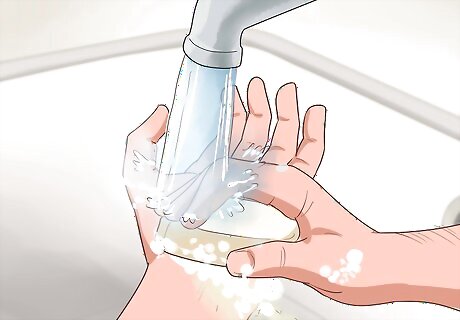
Clean your forearm, wrist and hand. Before applying any tape, make sure to wash your forearm, wrist and hand thoroughly with soap and warm water, then dry the entire area thoroughly with a clean towel. Leaving any moisture or oils on your skin will reduce the effectiveness of the adhesive (glue) on the back of the Kinesio tape. To remove all oils and grime, consider using some alcohol-based hand sanitizer after washing with soap and water. If you have especially hairy forearms and/or hands, then gently shave them at least one day before applying any tape so it will adhere to your skin better.
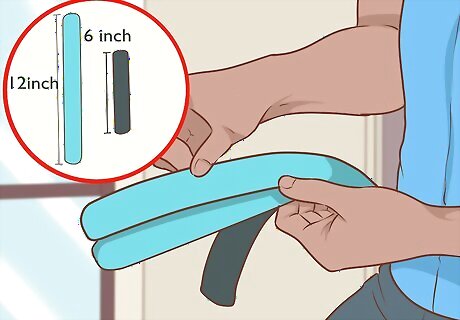
Set out the pre-cut strips of Kinesio tape. If you bought the Kinesio pre-cut wrist kit, then set out the strips on a counter or flat surface. The special wrist kit includes three strips: a long light blue one about 12-inches long, and two shorter black pieces about 6-inches in length each. The longer piece is meant for your forearm / hand, whereas the shorter black pieces are meant to wrap around your wrist for support. Realize that the Kinesio pre-cut wrist kit comes with tape that has a paper backing over the adhesive material, which makes it easier to cut to suit your body proportions. If your wrists are thin, you may be able to cut one of the black pieces in half and apply the two pieces separately for more support (see below).
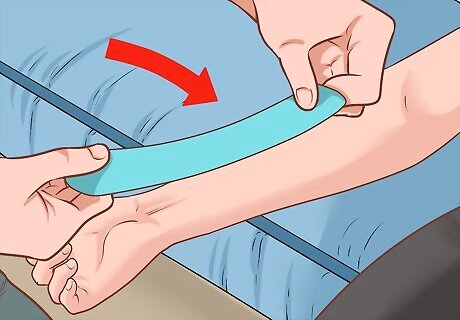
Apply a long piece to your forearm. Once you arm is clean and dry, the first piece of tape you apply is to your forearm. It should be long enough to run from just below your elbow, to halfway down the back of your hand — a few inches away from your knuckles. In most people, the distance is about 12 inches, but it could be more or less depending on your size and proportions. The long blue "I-strip" with the pre-cut wrist kit fits virtually everyone, although it may have to be trimmed if your forearm is relatively short. There are cutting guides on the back of the tape to help you. Before apply the long strip of tape, flex your wrist down so that your forearm muscles are put into a position of stretch or tension. When applying the Kinesio tape, try not to stretch it too much. Remove the paper backing, apply it firmly and press down on your skin so that it sticks well.
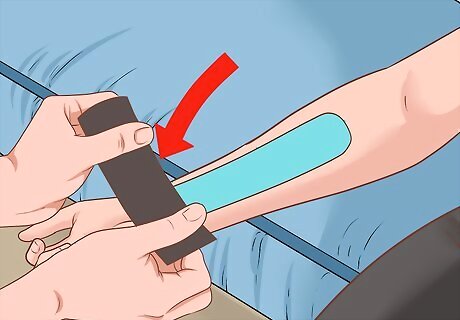
Apply a shorter band around your wrist. Once the forearm piece is firmly attached to your skin, a piece around your wrist needs to be applied as if it were a relatively tight bracelet. If you bought the pre-cut wrist kit, the black pieces are meant to wrap around your wrist. If your wrist is thin, cut a black strip in half and wrap your wrist twice for best support. Add a second band of tape to your wrist for better support, don't apply it too tight because you can cut off circulation (and nerve flow) to the hand and make your CTS worse. Apply Kinesio tape at least an hour before any physical activity in order to give the adhesive material (glue) enough time to thoroughly bind to your skin.
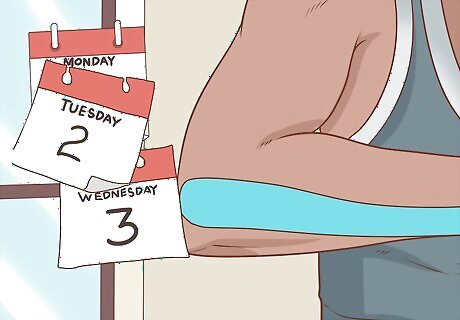
Re-tape within a week. Most Kinesio tape jobs can remain in place and be effective for three to five days with some athletic activity and normal bathing, although you may be able to get a week from it if you're inactive and really careful when washing. The point of taping your wrist is to provide continual support and pain relief from CTS, so when it feels loose and the symptoms get worse, it's time to re-tape it. Pulling the Kinesio tape off is usually pretty easy. If you're having trouble, try soaking your arm in warm water and/or using special tape-cutting scissors with blunt ends. CTS is a chronic condition, so you may need to tape your wrist for many weeks or months to get symptom relief if you can't find the cause. If the adhesive from the tape starts to irritate your skin, you may have to take a break for a few days or so to allow your skin to heal. Applying aloe vera gel can help skin heal quickly.
Cutting Your Own Tape for CTS

Wash and dry your arm and hand. Make sure to wash your forearm, wrist and hand thoroughly before applying Kinesio tape as moisture and skin oils reduce adhesion to skin. If you don't want to use an alcohol-based cleaner, consider using white vinegar or lemon juice to remove any tough grime from your skin. An alternative to shaving hairy arms is to remove hair with wax (temporary fix) or laser treatments (more of a permanent treatment). Allow you skin a day or two to heal from the hair removal procedure before applying Kinesio tape.
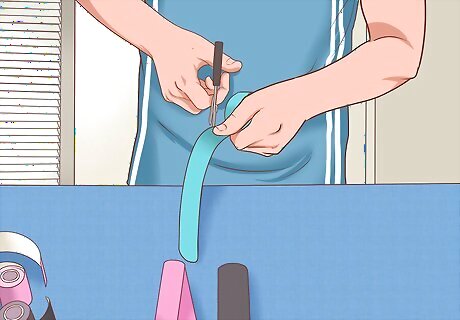
Cut your own Kinesio tape. If you bought a roll of Kinesio tape online or from your therapist, then you'll need to cut three pieces to approximately the same lengths (as mentioned above) with some sharp scissors. The longest piece should be about 12 inches (30 cm), and two shorter pieces should be between 4–6 inches long depending on the diameter of your wrist. Measure your wrist with a tape measure and then add an inch or so to figure out how much tape to cut. All cut strips should be trimmed with round corners so its more difficult for the edges to pull off your skin. When cutting adhesive tape, make sure your scissors are sharp and clean so it's easier to cut through the glue on the back. Use alcohol wipes to clean the scissors if needed.
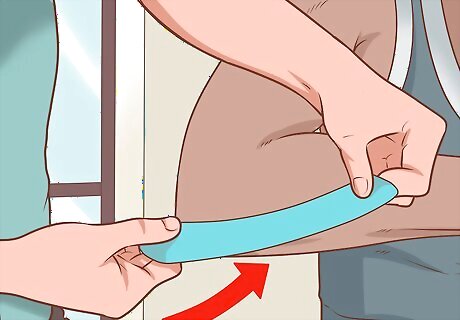
Apply tape to your forearm first. The first piece of cut tape you should apply is to your forearm, as it will act as an anchor for the band of tape you later put on your wrist. Before applying the tape, don't forget to flex your wrist down so that your forearm muscles are under tension. Place the tape directly over the muscles, which make up the most fleshy part of your forearm. Do not put tape over the elbow bone. The Kinesio tape can help alleviate some of the tension in your forearm muscles.
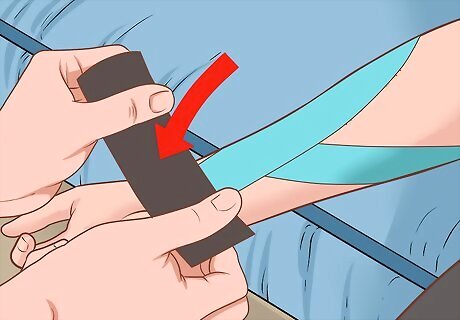
Apply tape around your wrist next. Once the forearm piece is down as an anchor, firmly apply a shorter piece around your wrist — a second piece might provide more support, as noted above, especially if you have a larger wrist with strong tendons and ligaments. With your role of Kinesio tape in hand, cut a piece long enough to wrap completely around your wrist without stretching the tape. Add a second band of tape to you wrist for better support, but wrap it in the opposite direction. Make sure the "joint" of the first piece is fully overlapped by the second. Reapply the tape within three to five days as noted above.
Preparing for Kinesio Taping Your Wrist

Get diagnosed with CTS first. Before taping or treating your wrist, it's important to know what's causing the pain or other symptoms. CTS is caused by median nerve compression within the the small carpal bones of the wrist. It's typically triggered by repetitive strains / sprains from overuse of the wrist, unusual wrist anatomy, poorly healed fractures and/or inflammatory arthritis. Typical symptoms of CTS include: pain, numbness, tingling and/or weakness within the wrist and hand. If you're experiencing similar symptoms in your wrist(s), make an appointment with your family doctor or neurologist so they can make sure it's CTS and not another disease, condition or injury. Electro-diagnostic studies, such as an EMG and nerve conduction, are often done to confirm a diagnosis of CTS.
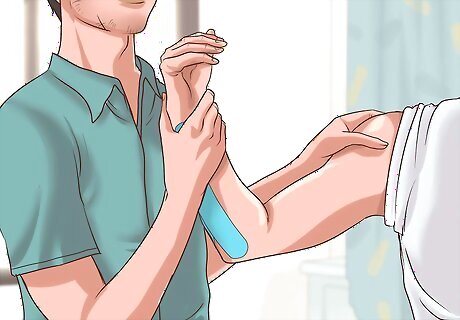
Make an appointment with a practitioner familiar with Kinesio taping. Once it's confirmed you have CTS and not some other condition that can mimic it (such as a hairline fracture), see a health professional experienced with Kinesio taping. Your doctor may know how to do it, but he/she will likely refer you to a sports physician, physiotherapist or chiropractor who has more experience and training with the techniques. At this stage, you should let the health professional tape your wrist with Kinesio tape so you can learn the technique and rational behind it, and then duplicate it at home. Watch the practitioner closely and don't be afraid to ask lots of questions so you're clear on the most effective way to tape your wrist. Other health professionals who deal with CTS and may use Kinesio taping include some massage therapists, acupuncturists or naturopaths.
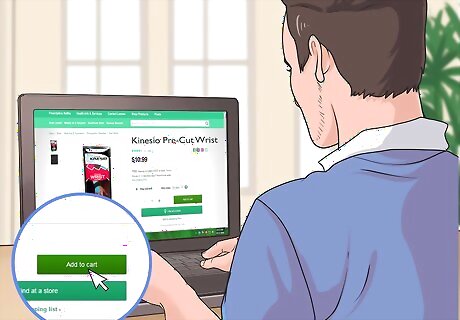
Get more information online and buy Kinesio tape. Once you're at home with your taped wrist, see how effective the Kinesio tape technique is for your CTS symptoms. If you think it's helpful, then watch videos and do more research online regarding Kinesio taping and where to buy it for home use. Your health practitioner (physio or chiropractor) may have some additional Kinesio tape to sell (or give) you, but there are many online sites to purchase from as well. Kinesio tape is available for the wrist as special pre-cut pieces, which makes it very convenient for taping CTS and other wrist injuries. Purchase this type online if at all possible for best results. Kinesio taping can typically be left on for several days (up to a week), depending on your activities, so that gives you enough time to do some research and order the tape before having to re-tape your wrist.



















Comments
0 comment